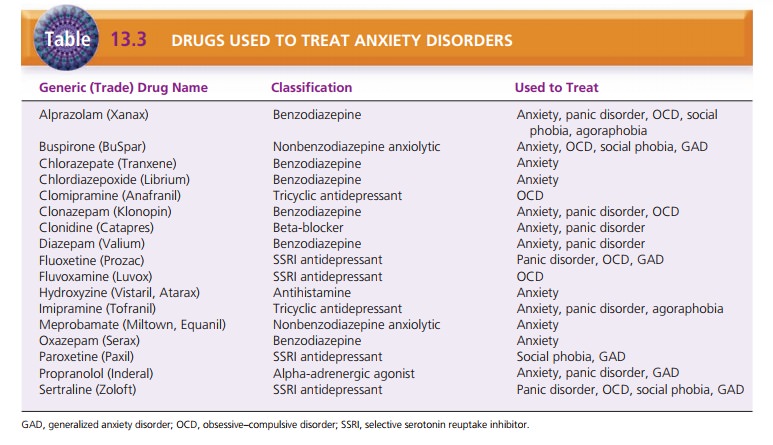Chapter: Psychiatric Mental Health Nursing : Anxiety, Anxiety Disorders, and Stress-Related Illness
Treatment - Anxiety, Anxiety Disorders, and Stress-Related Illness
TREATMENT
Treatment for anxiety disorders usually involves medica-tion and
therapy. This combination produces better results than either one alone
(Charney, 2005). Drugs used to treat anxiety disorders are listed in Table
13.3. Cognitive–behavioral therapy is used successfully to treat anxiety
disorders. Positive reframing means
turning neg-ative messages into positive messages. The therapist teaches the
person to create positive messages for use during panic episodes. For example,
instead of thinking, “My heart is pounding. I think I’m going to die!” the
cli-ent thinks, “I can stand this. This is just anxiety. It will go away.” The
client can write down these messages and keep them readily accessible such as
in an address book, a calendar, or a wallet.

Decatastrophizing involves the therapist’s use
of ques-tions to more realistically appraise the situation. The thera-pist may
ask, “What is the worst thing that could happen? Is that likely? Could you
survive that? Is that as bad as you imagine?” The client uses thought-stopping
and distrac-tion techniques to jolt himself or herself from focusing on
negative thoughts. Splashing the face with cold water, snap-ping a rubber band
worn on the wrist, or shouting are all techniques that can break the cycle of
negative thoughts.
Assertiveness training helps the person take more control over life situations.
Techniques help the person negotiate interpersonal situations and foster
self-assurance. They involve using “I” statements to identify feelings andto
communicate concerns or needs to others. Examples include “I feel angry when
you turn your back while I’m talking,” “I want to have 5 minutes of your time
for an uninterrupted conversation about something important,” and “I would like
to have about 30 minutes in the evening to relax without interruption.”
Related Topics